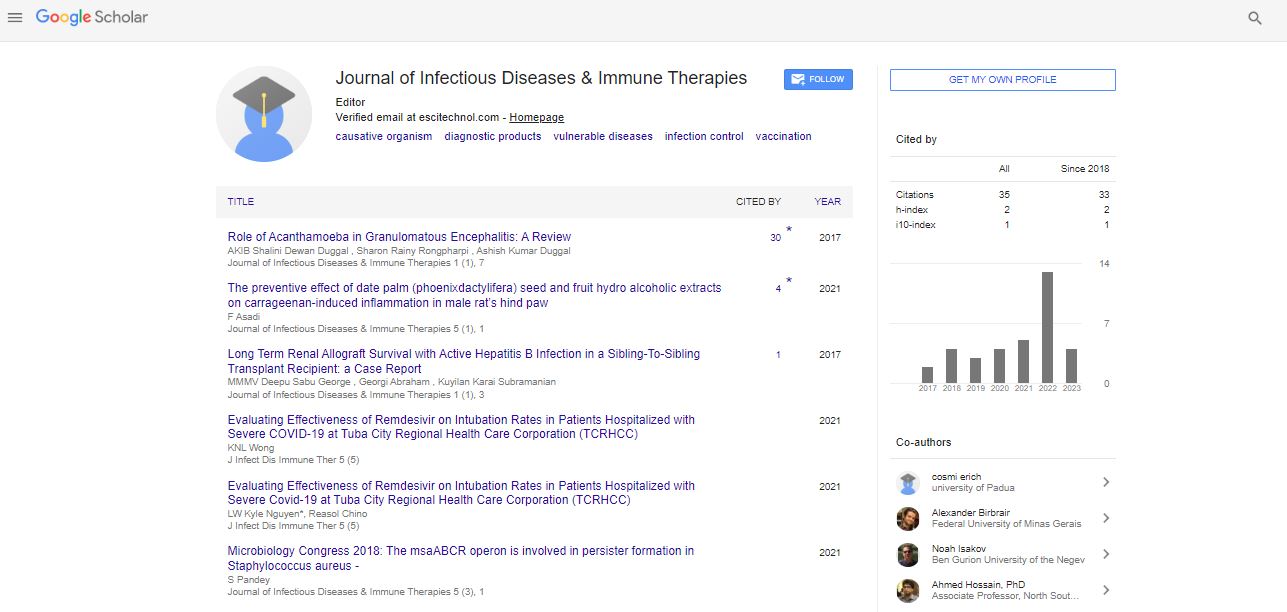Editorial, J Infect Dis Immune Ther Vol: 5 Issue: 6
Zygomycosis: Life-Threatening Fungal Infections
Jay Turnbul*
Department of Immunotherapy, University of Melbourne, Australia
*Corresponding Author : Jay Turnbul
Department of Immunotherapy, University of Melbourne, Australia, E-mail: jayturnbullwork@cloud.com
Received: November 01, 2021; Accepted: November 15, 2021 Published: November 22, 2021
Citation: Turnbul J (2021) Zygomycosis: Life-Threating Fungal Infections. J Infect Dis Immune Ther 5: 6.
Description
Zygomycosis is the widest word for infections produced by the zygomycota phylum's bread mould fungi. Because zygomycota has been discovered as polyphyletic and is not included in present fungal classification systems, the diseases that zygomycosis can relate to are better known by their specific names: mucormycosis, phycomycosis and basidiobolomycosis (after Basidiobolus). The face or oropharyngeal (nose and mouth) cavity are frequently affected by these infrequent but serious and sometimes life-threatening fungal infections. Infections of the zygomycosis kind are most commonly caused by fungus found in soil and rotting vegetation. While most people are exposed to fungus on a daily basis, those who have immunological problems (immunocompromised) are more susceptible to infection.
The lesions of the primary cutaneous type are frequently painful and necrotic, with black eschar and a fever. Typically, patients will have a history of poorly controlled diabetes or cancer. Amputation may be required if myocutaneous infectious disease is present. Patients undergoing lung transplants are at a higher risk of developing invasive mycoses, which can be deadly. Paranasal edoema with necrotic tissues is a symptom of rhinocerebral infection. As the fungus penetrate via blood vessels and other anatomical systems, the patient may experience hemorrhagic exudates (tissue fluid from lesions tinged with blood) from the nose and eyes. A potassium hydroxide (KOH) preparation in tissue is used to diagnose. On branches, light microscopy will reveal broad, ribbon-like septate hyphae with 90 degree angles. A KOH wet mount of black eschar will reveal aseptate fungal hyphae branching at right angles. The dermis and cutis will show similar broad hyphae when stained with Periodic Acid Schiff (PAS). A fungus culture can also be used to validate the organism's identity. Due to a lack of laboratory tests, diagnosis remains difficult, and mortality remains high. A multiplex PCR test identified five species of Rhizopus in 2005, and it could be beneficial as a screening approach for visceral mucormycosis in the future. More than 10 nodules and pleural effusion are associated with pulmonary manifestations of the disease, according to the clinical approach to diagnosis. A reverse halo indication is seen in CT. Diagnosis is still done using direct microscopy, histology, and cultures. Aspergillosis and Zygomycophyta have similar clinical and radiological characteristics. If no validated indirect diagnostics are available, invasive procedures such as bronchial endoscopy and lung biopsy may be required to confirm pulmonary diagnosis.
The use of a quantitative polymerase chain reaction to detect pathogen DNA in serum has shown potential. The gastrointestinal tract or the skin may be affected. It frequently starts in the nose and paranasal sinuses in non-trauma cases and is one of the most rapidly spreading fungal diseases in people. Thrombosis and tissue necrosis are two common signs. Zygomycosis has a high death rate due to the organisms' fast development and invasion. Treatment should start right away with necrotic tissue debridement and Amphotericin B. As suspected dead tissue must be removed forcefully, complete excision of the infected tissue may be required. In a documented case of sino- orbital infection, intravenous amphotericin B and cautious surgical drainage in an insulin-dependent diabetic was successful. The prognosis varies greatly depending on the conditions of each patient. Oomycota (/omastits/) or oomycetes (/omastits/) are a type of oomycota .They are filamentous, heterotrophic, and sexually and asexually reproducible. Contact between hyphae of male antheridia and female oogonia results in sexual development of an oospore; these spores can overwinter and are known as resting spores. The creation of chlamydospores and sporangia, which produce motile zoospores, is an example of asexual reproduction. Oomycetes have saprophytic and pathogenic lives, and some of the most well-known plant infections, such as late blight and sudden oak mortality, cause catastrophic diseases.
 Spanish
Spanish  Chinese
Chinese  Russian
Russian  German
German  French
French  Japanese
Japanese  Portuguese
Portuguese  Hindi
Hindi 